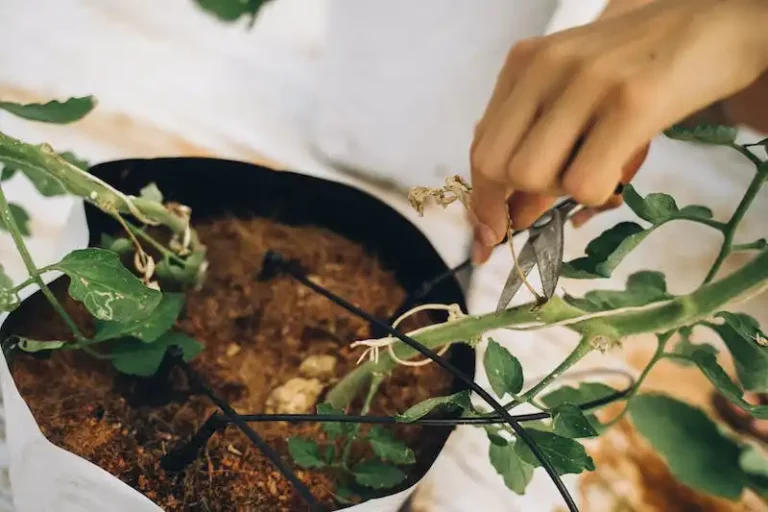Pruning is an essential task for plum tree care. Properly pruned trees not only have a better overall structure, but they also produce more fruits and are less prone to diseases. In this article, we will learn how to prune plum trees to achieve the best results.
The first step in pruning plum trees is to choose the right time. The ideal time to prune plum trees is during late winter or early spring, when the tree is still dormant. This is when the trees have lost their leaves and the branches are more visible. Pruning during this time will help create a framework and remove any weak or diseased branches.
When pruning plum trees, it is important to have the right equipment. A pair of sharp secateurs is the best choice for this project. Make sure to clean them before and after use to avoid spreading any diseases. You may also need a pruning saw for larger branches.
Before you start pruning, it is important to have a clear goal in mind. Do you want to create an open-center or vase-shaped tree? Or do you prefer the central-leader framework? For a vase-shaped tree, remove the central leader and select three to five well-spaced branches to form the main structure. For a central-leader tree, leave the main central leader intact and prune the side branches to create an evenly spaced framework.
When pruning plum trees, it is important to remove any suckers or water sprouts that may have grown along the trunk or branches. These shoots can weaken the tree and lead to overproduction of fruits. Additionally, remove any crossing or rubbing branches to prevent damage to the tree and encourage healthy growth.
When pruning plum trees, it is also important to thin out the canopy to allow more light and air circulation. Remove any branches that are growing towards the center of the tree or crossing each other. This will encourage better fruit ripening and reduce the risk of diseases. However, be careful not to remove too many branches, as this can result in sunburn or damage to the tree.
After pruning, it is important to clean up and dispose of any diseased or damaged materials properly. You can either burn them or take them to a designated compost area. This will help prevent the spread of diseases and pests.
Plum Tree Pruning: Learn About How And When To Prune A Plum Tree
Pruning plum trees is an essential part of their care. Proper pruning helps shape the tree and promotes healthy growth. Here are instructions on how and when to prune a plum tree:
- Prune plum trees in late winter or early spring, before the buds start to break. This is typically in March, depending on your location.
- Start by removing any diseased or damaged branches. Look for branches that are dead, broken, or crossing through the center of the tree.
- Next, examine the tree’s overall shape and aim to prune it into a pyramid shape. Remove any branches that are growing vertically and aim to create a well-spaced and balanced structure.
- Thin the tree by removing suckers and water sprouts. Suckers are shoots that grow from the roots, and water sprouts are vigorous vertical shoots that grow from branches. Removing them allows more light and air circulation.
- When pruning, make clean cuts using sharp and clean secateurs. Cut just above a bud or a lateral branch, angling the cut away from the bud or branch.
- For larger cuts, use a 3-step method. First, make an undercut a few inches away from the branch collar, then make a top cut slightly further out. Finally, make a final cut just outside the branch collar, parallel to the branch bark ridge.
- If the tree has any japanese beetle holes or silver leaf fungus, prune the affected branches and seal the wounds with a pruning sealer.
- Leave some of the young, unfeathered wood on the tree. This wood produces fruiting spurs for future crops.
- Prune older trees more aggressively, removing some larger branches to rejuvenate the tree and promote new growth.
- Keep in mind that plum trees have a tendency to overproduce fruit, which can lead to small and poorly ripened fruits. Pruning helps regulate fruit production and improves fruit quality.
- Remember to consider the tree’s natural growth habits when pruning. Plums tend to grow more upright, while other types may have a more spreading habit. Prune accordingly to direct growth in the desired shape.
- If you have little experience with pruning, consult pruning guides or hire a professional to ensure proper techniques are followed.
Proper pruning provides plum trees with the care they need to flourish. Pruning helps maintain the tree’s shape, improves sunlight and air circulation, reduces disease risk, encourages fruit production, and makes harvesting easier. Follow these tips and instructions, and your plum tree will have a bumper crop of delicious plums!
When to Prune a Plum Tree
Pruning a plum tree at the right time is crucial for its overall health and fruit production. Pruning at the correct time can invite better circulation of air and sunlight, resulting in a fruitful tree.
It’s best to prune plum trees during the dormant season, which is typically from late winter to early spring. Pruning during this time greatly reduces the chance of spreading fungal diseases and helps the tree heal faster.
When pruning a plum tree, start by removing any dead, damaged, or diseased branches. Also, prune any branches that are crossing or rubbing against each other. This will help maintain an open framework and allow for better air circulation and light penetration.
To properly prune a plum tree, begin by cutting branches at a 45-degree angle just above an outward-facing bud or a whorl of buds. This will encourage new growth to grow in the desired direction and prevent water from sitting on the cut, which could lead to disease.
If you’re not sure which branches to remove, consult pruning guides or seek advice from a professional arborist. They will be able to provide you with specific instructions based on the type and age of your plum tree.
It’s important to use clean and sharp secateurs when pruning. Before making any cuts, disinfect the blades with a diluted bleach or alcohol solution to prevent the spread of diseases.
After pruning, it’s a good idea to mulch around the base of the tree. This helps retain moisture, suppresses weed growth, and provides additional protection to the roots during extreme temperatures.
Remember, the goal of pruning a plum tree is to maintain a balanced shape and encourage healthy growth. By pruning correctly and at the right time, you’ll have a better chance of a healthy and productive plum tree.
How to Prune a Plum Tree The First Three Years
Pruning plum trees in the first three years is crucial for their proper growth and to ensure a healthy and productive tree. Proper pruning helps shape the tree and encourages the growth of strong branches that can withstand the weight of fruit.
| Year 1 | Year 2 | Year 3 |
|
During the first year, focus on forming the basic structure of the tree. Choose the strongest main stem to become the central leader, removing any competing stems or branches. Ideally, select side branches that are evenly spaced and have an upward angle of about 45 degrees from the main stem. This will create an open vase shape, allowing sunlight to reach all parts of the tree. |
In the second year, the tree will have developed more branches and foliage. Pruning during this year should focus on thinning out overcrowded areas to allow for better airflow and sunlight penetration. Remove any crossing or rubbing branches, as well as any vertical stems that are growing too vigorously. Prune to maintain an open and balanced shape. |
By the third year, your plum tree should be well-established. Pruning now becomes a matter of maintaining the proper shape and encouraging new growth in the right places. Remove any dead, damaged, or diseased branches. Thin out any overcrowded areas by cutting branches that are crossing each other or growing too closely together. Focus on removing branches that are growing inward towards the center of the tree, as well as those that are growing too vertically. |
When pruning your plum tree in the first three years, there are a few important factors to keep in mind:
- Prune during the dormant period, generally in late winter or early spring, before new growth begins.
- Make clean cuts at a 45-degree angle, just above a bud or a crotch where the branch meets the trunk.
- Remove any shoots or sprouts that arise from the base of the tree, as these can compete with the main branches for nutrients.
- Regularly thin out the fruit to ensure a bumper crop and to prevent branch breakage. Use secateurs to snip off excess fruit when they are about the size of a marble.
- If you notice any branches that have become too heavy or are bending downward, use stake supports to lift them back up and prevent breakage.
Following these instructions for pruning your plum tree during its first three years will help it grow into a healthy and productive tree. It’s essential to learn about your specific plum tree variety and take its growth habits into account when pruning. By correctly shaping and caring for your plum tree, you can enjoy abundant and delicious fruit for many years to come.
How to Prune a Plum Tree When Established
Pruning a plum tree when it is established is important to ensure the best fruit production and overall health of the tree. Here are some tips on how to prune a plum tree:
| Tip #1 | Prune the tree in late winter or early spring, before it starts to grow. This will help stimulate new growth and shape the tree. |
| Tip #2 | Remove any dead or diseased branches. This will help prevent the spread of diseases and improve the overall health of the tree. |
| Tip #3 | Thin out any branches that are crossing or rubbing against each other. This will improve air circulation and prevent disease and pest problems. |
| Tip #4 | Prune the tree to an open center shape. This allows sunlight to reach all parts of the tree and promotes better fruit production. |
| Tip #5 | Remove any sprouts or suckers that grow from the base of the tree. These will take energy away from the main tree and can eventually overtake it. |
| Tip #6 | Trim back any branches that are overly vigorous or growing too close to each other. This will prevent overcrowding and improve the overall shape and structure of the tree. |
| Tip #7 | Wrap the tree with silver material in July to protect it from bird damage. This will help ensure that the fruit crops are not eaten by birds before they are ripe. |
| Tip #8 | Consider using a pruning sealer on larger cuts. This helps to protect the tree from disease and encourages healing. |
| Tip #9 | Learn about the specific needs of your plum tree variety. Different types of plum trees may have slightly different pruning requirements, so it’s always a good idea to consult specific guides if needed. |
By following these tips, you can help ensure that your plum tree remains healthy, well-formed, and produces great-tasting fruit for years to come.




